Development of Maritime Civilization
(credit: Imagico and AncientAfricanHistory.com)
1. Semliki (90,000 BC) - oldest harpoon
2. El Damer (8050-7800 BC) - early fishboating
3. Aneibis (7900-7600 BC) - early fishboating
4. El Salha (7050-6820 BC) - early large ship on pebble
5. Sabu Jaddi (4500 BC) - early large ships on rocks
6. Wadi Barramiya (4000 BC) - early large ships on rocks
7. Wadi Abu Subeira (4000 BC) - large ships on rocks
8. Wadi Abu Wasil (4000 BC) - early large ships on rocks
9. Gerzeh (3600 BC) - large ships on pottery
10. Qustul Cemetery (3300 BC) - ship on incense burner
11. Nag el-Hamdulab (3200 BC) - large ships on rocks
12. Abydos (2920-2770) - early wooden ships
13. Wadi al-Jarf (2500 BC) - oldest sea port
14. Menefer (2500 BC) - oldest documented sea voyage
15. Giza (2485 BC) - early large ship, oldest river port
16. Wadi Gawasis (1900 BC) - early sea port
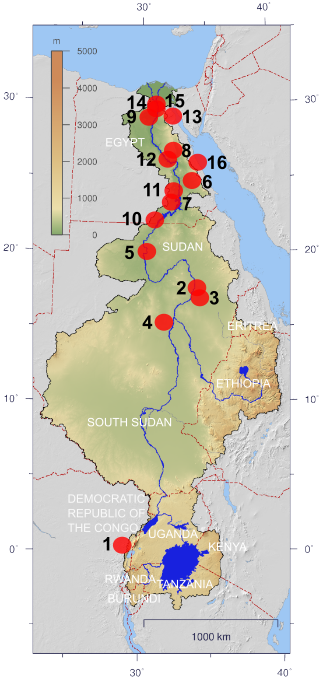 |
Nile Valley Maritime History
Large-scale farming along the river banks coupled with the routine use of boats created the world's oldest known maritime trade routes
along the Nile, the Red Sea and the Mediterranean. At the center of this vast trading network, Kush (also known as Ethiopia or Nubia)
and Kemet (Egypt) became extremely wealthy and powerful empires--and the world's oldest documented maritime civilizations. Although it is uncertain precisely when Nilotic Africans
began using ships for trade or in everyday life, preliminary evidence suggests they were boating at least 10,000 years ago.
Archaeozoological work at sites along the Atbara River (a Nile River tributary in Central Sudan) revealed
evidence that suggests the early use of boats for fishing. At the
El Damer (8050-7800 BC) and Aneibis (7900-7600 BC) sites, evidence of the large-scale consumption of fish that do not typically come ashore suggests the use of fishing boats.
Combined with the development of large-scale agriculture on the banks of the Nile, ships became the
primary mode of trade and transportation.
Early Representations of Ships
Evidence of the use of large ships can be found at the El Salha Archaeological Project,
located to the west of Khartoum in Central Sudan (at the confluence of the Blue and White Niles), where the image of a typical
"Dynastic Egypt" style vessel is etched on a granite pebble dating between 7050 and 6820 BC (Khartoum Mesolithic Group).
Dozens of petroglyphs that depict more elaborate large ships with tall sailing masts, large oars, covered superstructures and chairs have been found
in central Sudan at Sabu Jaddi (4500 BC) and Egypt's Central Eastern Desert at Wadis Abu Subeira, Abu Wasil, Baramiya, Gharb Aswan, Hajalij,
Hammamat, Kanais, Mineh, Nag el-Hamdulab, Qash, and Salam (early Naqada I period, 4400-3500 BC). Pottery and linen with representations of
ships bearing large sails and multiple oars also appeared during the so-called "Naqada II Period" (3600 - 3250 BC).
A large ship with oars depicted on pottery (3600-3250 BC), at the British Museum
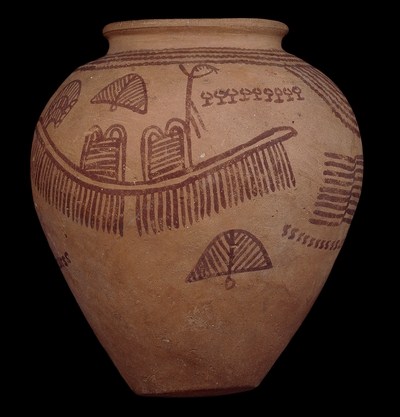 |
Petroglyphs of early large ships at Sabu Jaddi, Sudan (4500 BC) (credit: Clemens Schmillen)
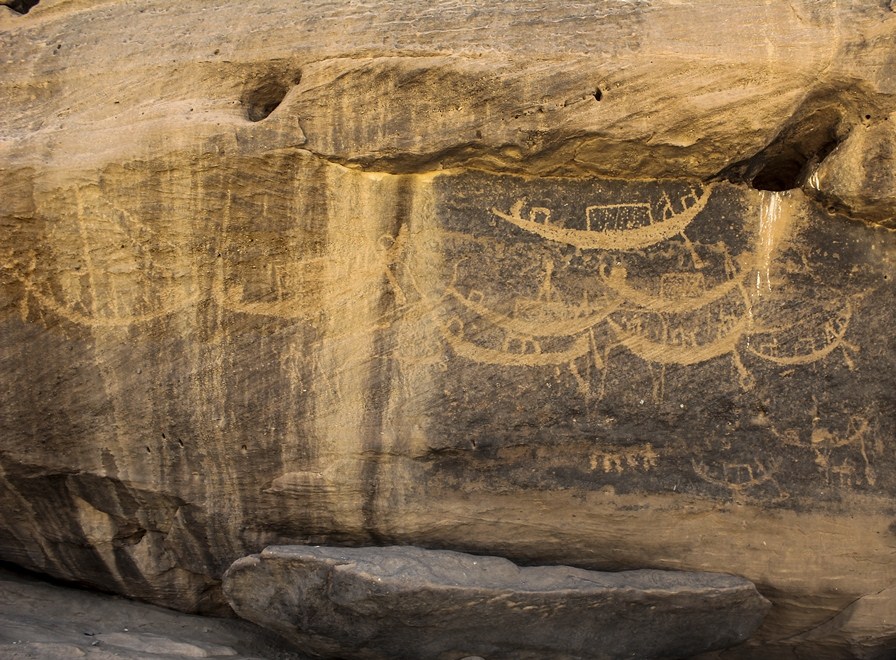 |
A large ship with multiple rowers and oars on linen, from a tomb in Gebelein near Waset (3600 BC), at the Torino Museum
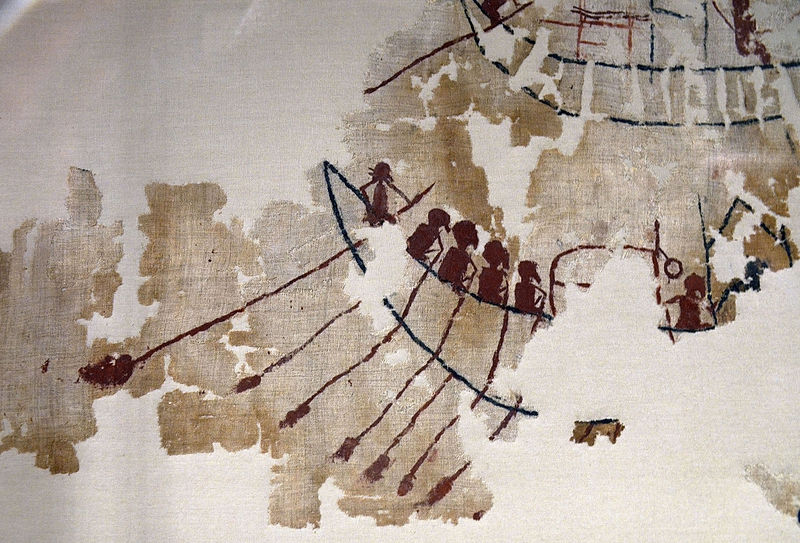 |
A sailboat on pottery found in Hu near Waset (3600 BC), at the British Museum
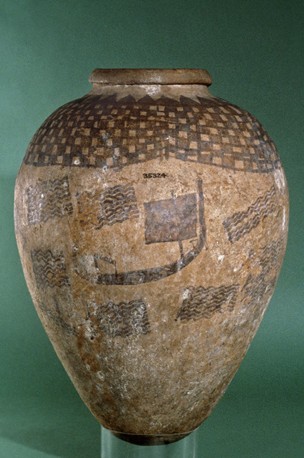 |
Ships as Early Cultural Symbols
In the same period, models of boats were buried in predynastic tombs at Hu and Gebelein near Waset, a cultural practice that would continue
for thousands of years--and a testament to the importance of the boat in everyday life.
While some models and paintings of boats clearly represented actual ones used for fishing, sporting or for ceremonial purposes, others
were apparently symbolic representations of the solar barque called "Atet", which ferried the Nilotic solar deity Ra through the sky
over the 12 hours of the day. Ra also took the form of the rising sun deity Khepri and was often depicted as a scarab
accompanied by two people on a boat. This depiction closely resembles older representations on predynastic pottery, such as the
one shown below from the Naqada II Period, featuring a human figure with arms raised next to two others on a ship.
A model boat (4400-4000 BC) that may have represented Atet from a tomb at Abadiyeh near Hu (credit: Petrie Museum)
 |
A model boat (3600-3250 BC) that likely represents an actual hunting or sporting
boat from a tomb at Gebelein near Waset (credit: Sandstein)
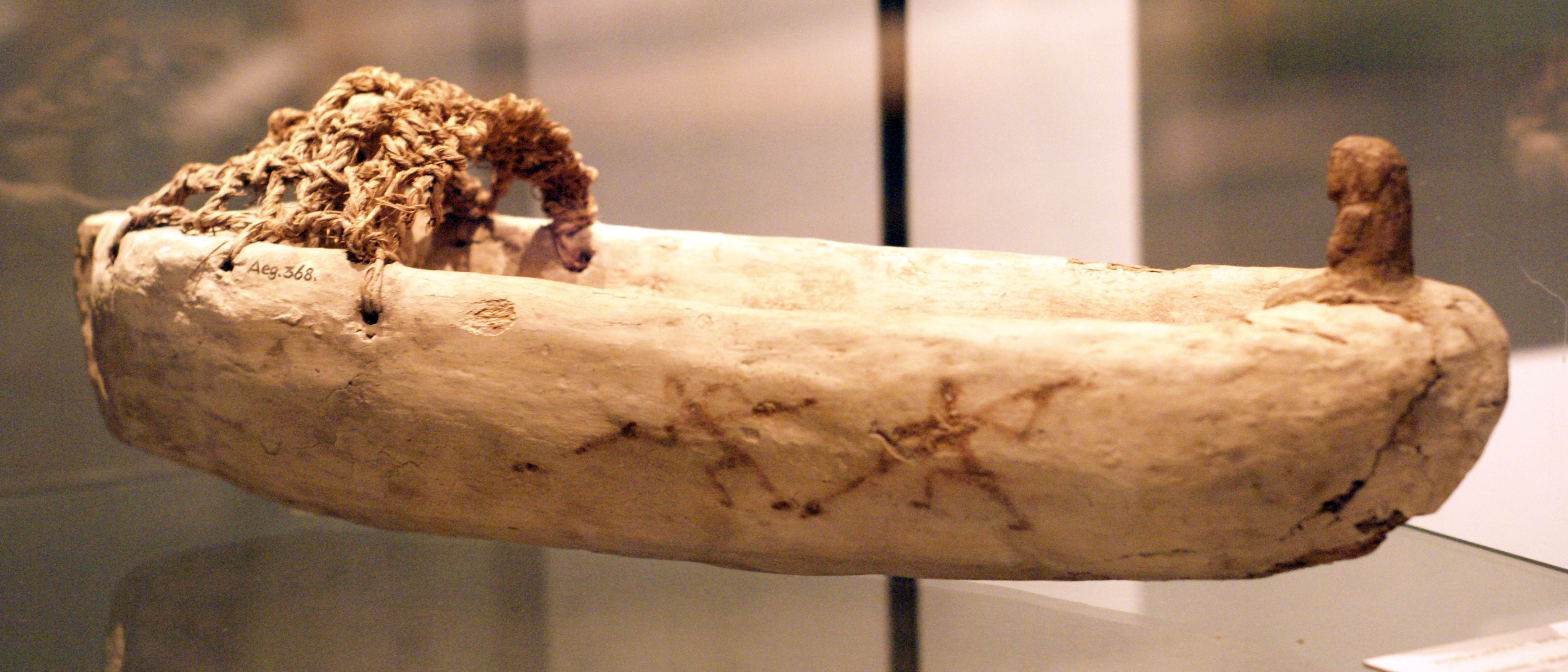 |
Khepri on Atet at the tomb of Ay near Waset (1327-1323 BC) (credit: kairoinfo4u)
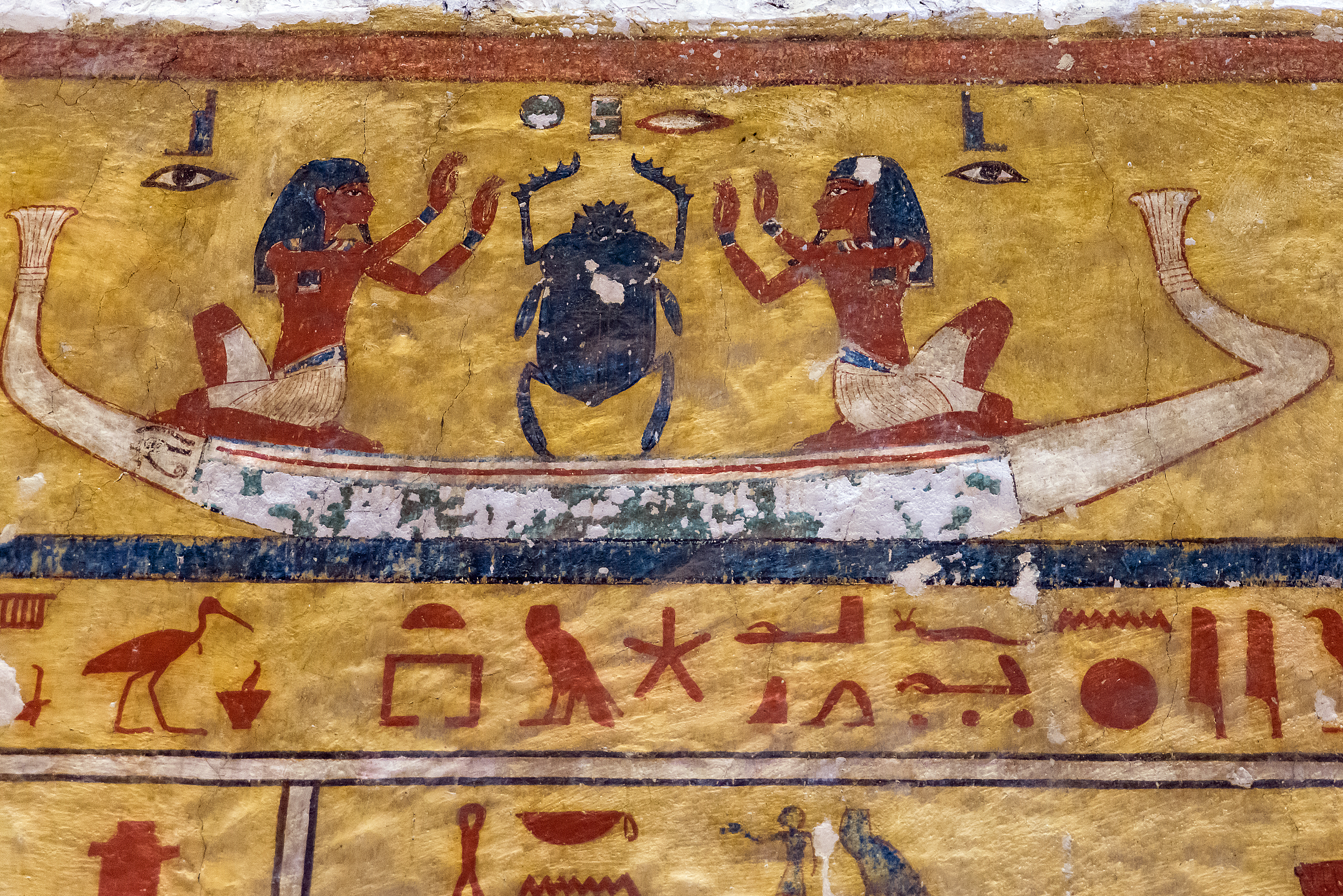 |
Likely an early representation of Atet and Khepri on pottery (3600-3250 BC) (credit: Brooklyn Museum); compare to the image on the right
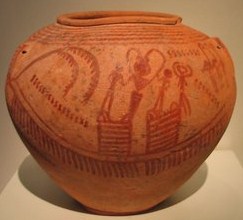 |
Khufu's ship at Giza (2580 BC) (credit: Bradipus)
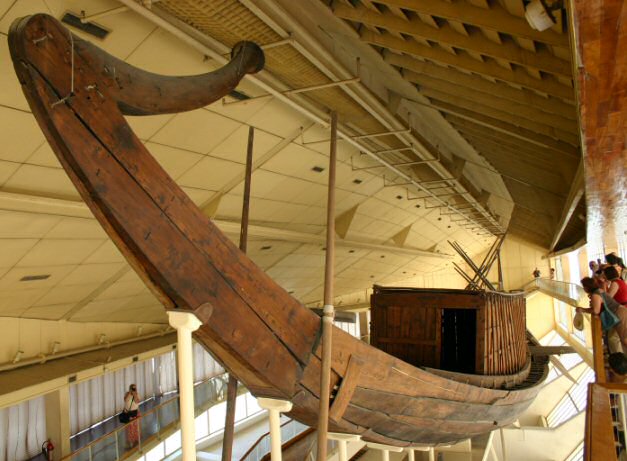 |
Early Large Ships & Shipbuilding
Actual large ships dating back 5,000 years have been found buried along the Lower Nile as well. Archaeologists
uncovered 14 wooden vessels that measure as much as 75 feet long and 10 feet wide and were buried in long brick enclosures
near Abydos. While the ships are located at the tomb of Khasekhemwy (2nd Dynasty, 2675 BC), they were
likely buried many years earlier during the reign of Aha (1st Dynasty, 2920-2770), making them the world's oldest wooden boats that
are not dugout canoes (such as the 8,500-year-old Dufuna canoe found in Nigeria). Other wooden ships of the same era were found buried at tombs near Saqqara and Menefer. But the
remains of the largest ancient seafaring vessel ever discovered was buried next to Khufu's (4th Dynasty, 2586-2566 BC) "Great Pyramid"
at Giza.
A depiction of shipbuilding from the Tomb of Ti at Saqqara (2492-2345 BC) (credit: Berthold Werner)
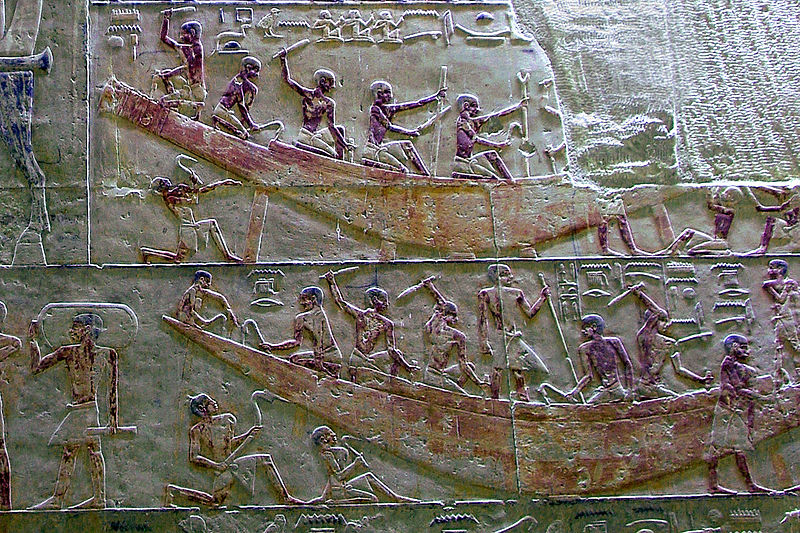 |
Generally believed to be mere funerary symbols like some model boats, as mentioned above, some scholars agree that such
ships were used for various practical purposes, including making actual pilgrimages
and for holding ceremonies, as further explained below. Indeed, archaeologists successfully reassembled
the 1,224 timber pieces of Khufu's ship (shown at right), which measures 143 ft (44 m) by 19.5 ft (6 m), or more than twice as long as
Christopher Columbus' longest vessel. The ship's cedar timbers were likely imported from the Levant, attesting to Khufu's trading
ties overseas and further corroborated by the fact that Khufu's name is reportedly etched on ancient alabaster vases found at the Temple of Balaat at the ancient port city of Byblos,
Lebanon. To no surprise, the building of such wooden ships was thoroughly documented. For example, on the mastaba of Ti at Saqqara
(2494-2345 BC), there are numerous depictions of ship building, with multiple workers using the
hand axe and other tools in the construction and/or repair and maintenance of ships.
World's Oldest Ports
Not far from Khufu's ship, archaeologists uncovered the ruins of an
extensive port dating to at least 2500 BC. Moreover, the evidence of juniper, pine and oak trees, which are not native to Egypt,
confirms trade with regions of the Levant and Western Asia. At Wadi al-Jarf on the Red Sea, archaeologists also
discovered
evidence of a port that dates to the same era. There are numerous ancient docks, or galleries carved
into stone, that contain ropes, anchors covered with writing, pieces of ship sails and oars, food storage jars, and
the world's oldest known papyrus documents. And farther south at Wadi Gawasis,
archaeologists discovered an ancient port with Dynastic stelae dating as far back as the Twelfth Dynasty
(1991-1802 BC), docks, ship timbers, ropes, anchors and in-tact oars, and
pottery (1400-1500 BC). It is worth noting that this port is near the closest point on the Red Sea to the
ancient capital city of Waset (Thebes).
Oldest Documented Trading Expeditions by Sea
Historical documents from the same era attest to overseas trade voyages made by Old Dynasty leaders. The so-called
"Palermo Stone" (2500 BC) describes such an expedition by Sneferu (4th Dynasty, 2613-2589 BC) that brought back 40 ships from
the Levant full of cedar logs, which were nonexistent in the arrid Lower Nile but heavily used for shipbuilding.
King Sahure, who made the first documented voyage to Punt (2580 BC)
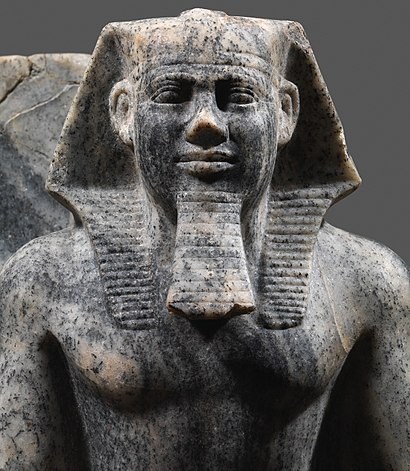 |
Sahure (5th Dynasty, 2487-2475 BC) also documented his trade missions with the Levant. Inscriptions in his pyramid at Abusir
show sailors raising a tall mast on a large sailing ship, as well as large shipments of timber, jugs and even brown bears, which are
not native to Africa. Archaeologists even found an ancient axe head attributed to Sahure's sailing crew that docked at the coastal
Lebanese city of Nahr Ibrahim.
Historical documents also suggest trade with the southern Land of Punt was just as strong. The Palermo Stone describes
Sahure's trade missions that returned large quantities of myhrr, timber and precious metals from Punt.
Sailors raising the ship's mast, Sahure's pyramid (2475 BC) (credit: Miguel Hermoso Cuesta)
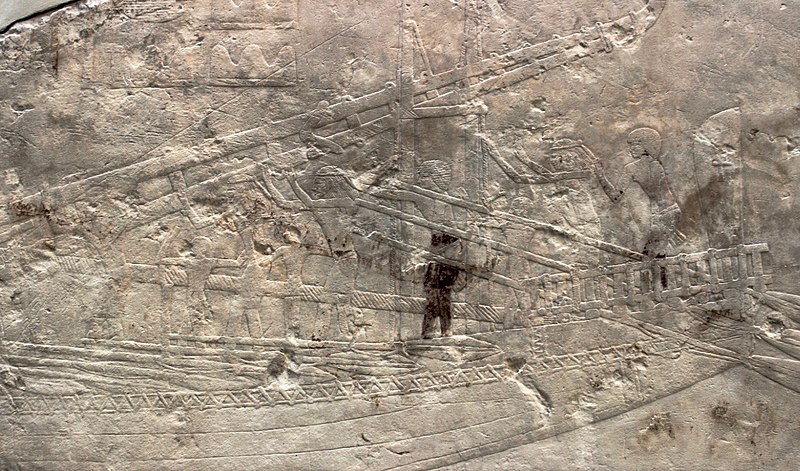 |
Bears and jugs imported from the North, Sahure's pyramid (2475 BC) (credit: Agyptisches Museum und Papyrussammlung)
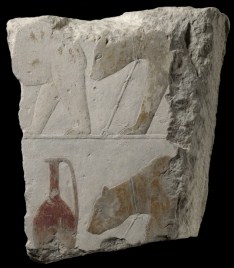 |
A statue of Hatshepsut, at the Egyptian Museum (1507-1458 BC)
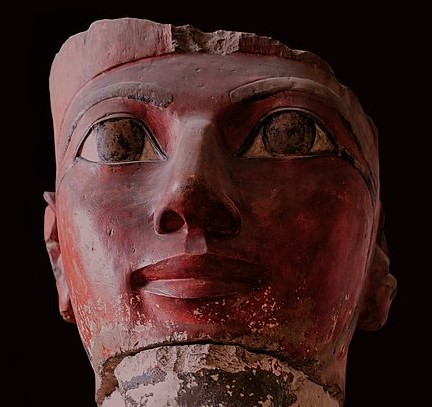 |
Perhaps the largest and most famous trading voyage to Punt, however, was taken by Queen Hatshepsut (18th Dynasty, 1507-1458 BC), as well documented in her temple at Deir
el-Bahri. Inscriptions detail Hatshepsut's crew carrying potted trees and what appear to be branches from the boswellia tree, which produces frankincense
and is native to Central Africa, Sudan, Somalia, Eritrea, Ethiopia, Oman, Yemen and India--suggesting the Land of Punt was in this region. However, the
depictions of Punt include animals native only to Africa, such as the giraffe, two-horned rhinoceros, baboon and hippopotamus,
confirming Punt was in Africa. Furthermore, researchers from the
University of California determined that a mummified baboon brought from Punt and found buried at Queen Hatshepsut's tomb was similar to species
from South Sudan, Ethiopia or Eritrea as opposed to Somalia. While scholars generally assume that Hatshepsut's voyage to Punt embarked
from Wadi Gawasis, the southernmost ancient Kemetic port discovered on the Red Sea, it is also possible that it was a voyage on the Nile River.
Indeed, the depictions of small, dome-roofed buildings on
stilts are similar to traditional Toposa structures primarily found along the Nile in South Sudan, not anywhere on the Red Sea.
Hatshepsut's crew carrying boswellia from Punt, temple at Deir el-Bahri (1450 BC) (credit: Σταυροζ)
 |
Hatshepsut's crew rowing oars of ship bound for Punt, temple at Deir el-Bahri (1450 BC) (credit: Agyptisches Museum und Papyrussammlung)
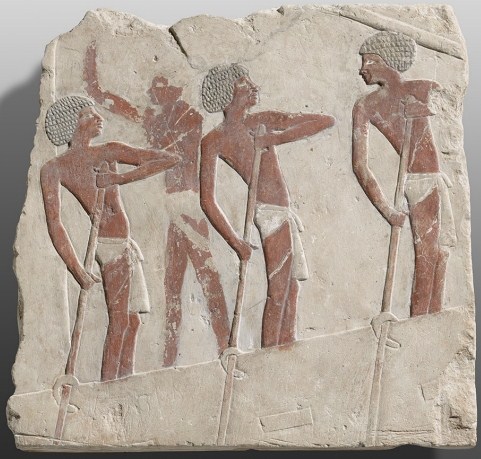 |
A depiction of Punt, temple at Deir el-Bahri (1450 BC) (credit: Hans Bernhard)
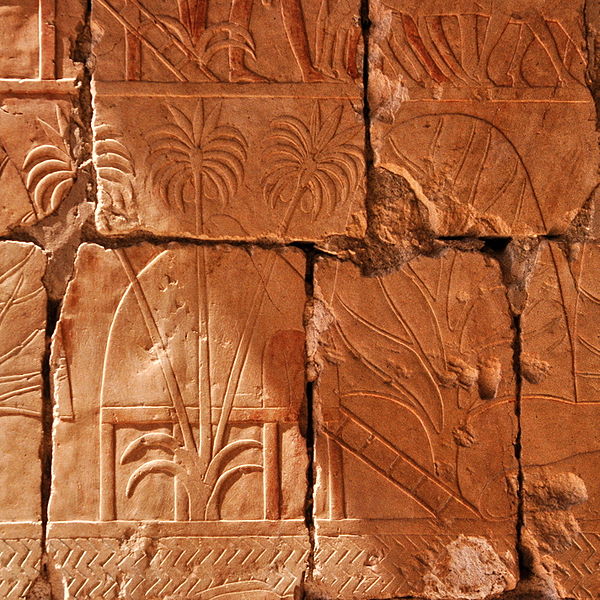 |
Hatshepsut's crew carrying a tree from Punt, temple at Deir el-Bahri (1450 BC)
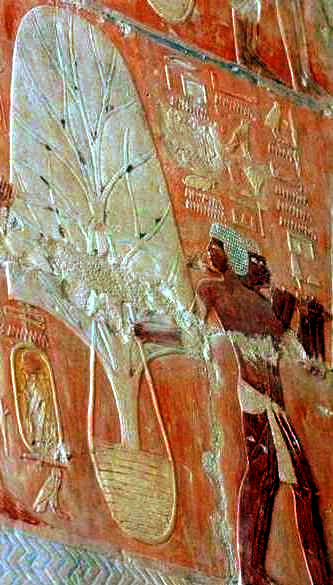 |
At the same port, archaeologists located the stela of Khentkhetwer who served under Amenemhat III (12th Dynasty, 1860-1814 BC),
which specifically mentions safely returning to this port (called "Saww") from the Land of Punt. Archaeologists also
located dozens of ancient
cargo boxes specifically labeled with Amenemhat IV's (12th Dynasty, 1990-1800 BC) name and as containing products from Punt.
The longest known voyage, and the world's first to circumnavigate Africa, was taken by Necho II (26th Dynasty, 610-595 BC). According to early Greek historian Herodotus
(Histories 4.42), Necho II sent a fleet of ships
from a port on the Red Sea, south around the continent of Africa, to the Nile. Herodotus also reported that unlike in the northern hemisphere,
the sun rose and set in a different part of the sky as the sailers sailed around southern Africa, lending credence to Herodotus'
account.
Nile Commerce and Trade
As imports of foreign goods like timber expanded, the trade of Nile Valley staples such as wheat, papyrus, wine, cattle, textiles
and precious metals flourished. Scenes on the walls of the tomb of Khaemwaset, west of Waset (1500 BC), show grape cultivation,
winemaking, bottling and transporting via ships. At the nearby tomb of Unsu (1450 BC), there are detailed depictions of farmers
seeding and tilling the soil, and harvesting and loading grain onto a boat. In the same region, at the tomb of
Amenhotep Huy (1400 BC), large groups of people are seen shipping gold, furniture, shields made of animal skin,
cattle, giraffes and what appear to be horses or donkeys on well decorated ships (contrary to popular misinformation, the people
atop the ship are not "captives", as their hands clearly are not tied behind their backs).
Shipping horses and other products (1400 BC) (credit: kairoinfo4u)
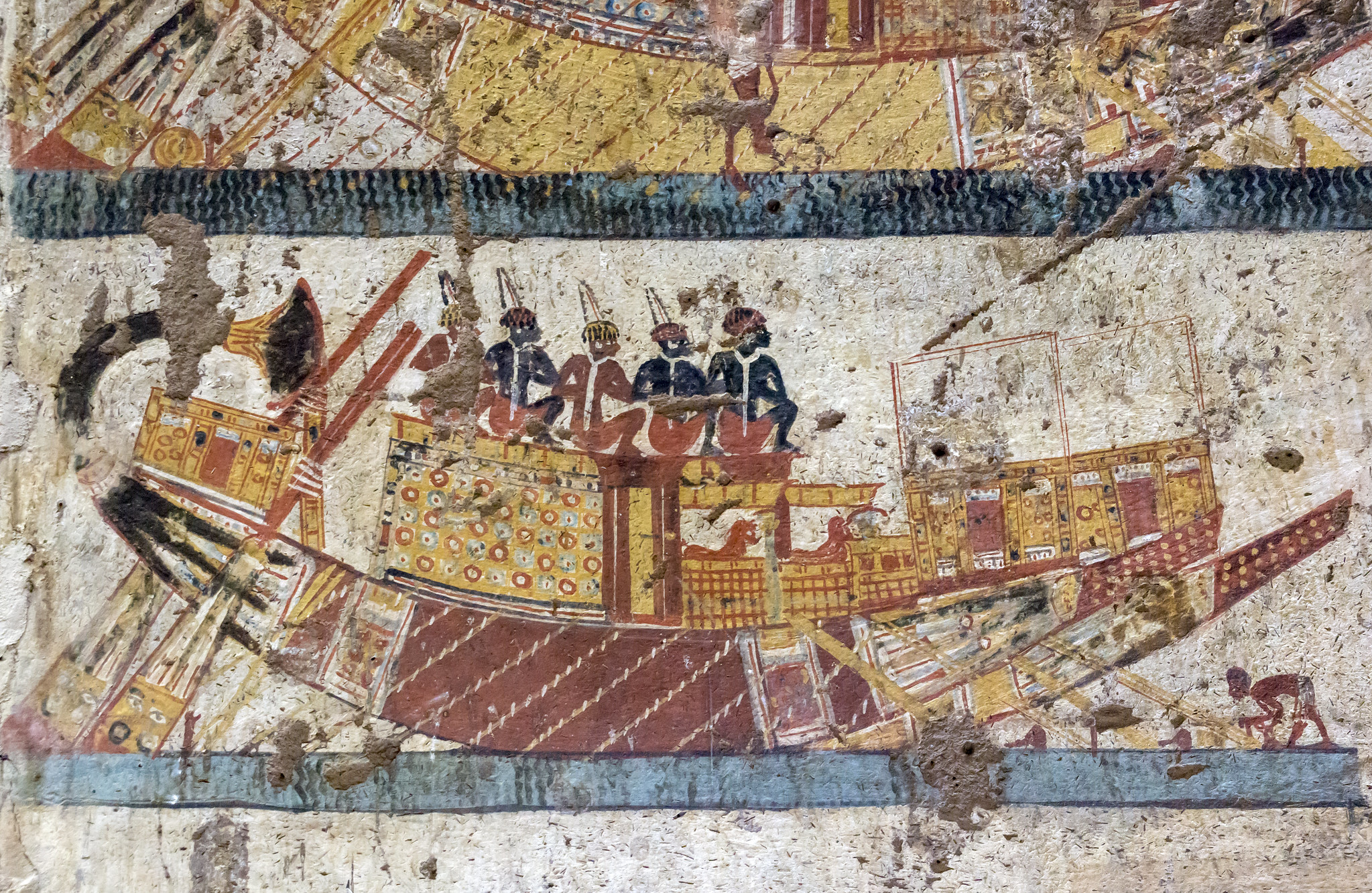 |
Offloading wine shipments, from the tomb of Khaemwaset west of Waset (1500 BC)
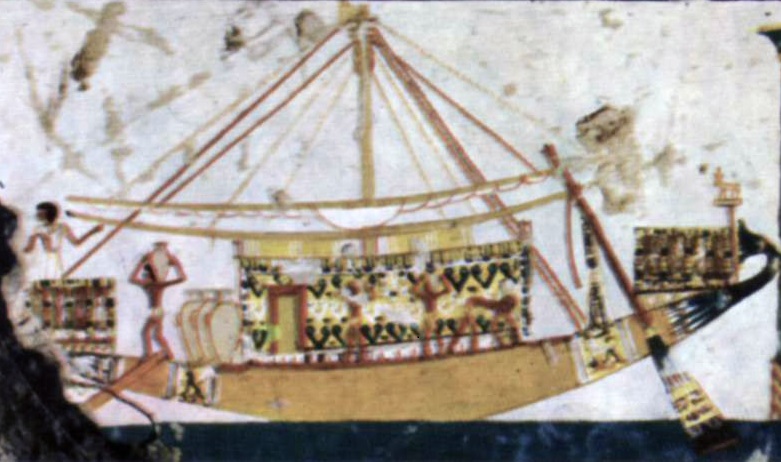 |
Shippers pour grain into a container on a ship, from the tomb of Unsu at Waset (1450 BC) (credit: Nadine Guilhou)
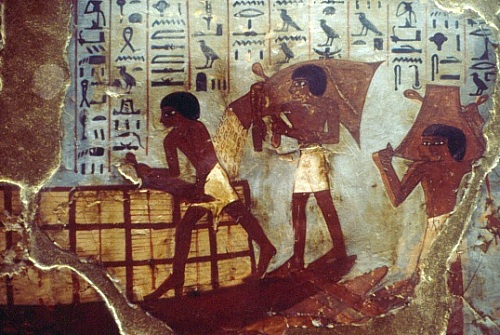 |
Sporting, Fishing and Hunting
Boats were not only used for major commercial trading but for various practical uses in everyday life. Fifth Dynasty paintings from
an unknown tomb at Saqqara, show men standing on small reed boats participating in a fighting sport involving small balls and spears.
Nearby, at the mastaba of Nikauisesi near Saqqara (2500 BC) show organized trips on reed boats to hunt fowl and fish. Such elaborate
hunting scenes became common in tombs in Saqqara and were portayed in a similar manner in tombs elsewhere, especially at the
so-called Theban necropolis centuries later. Famous examples are seen on the walls of the tomb of Nebamun near Waset (1350 BC) and
the tomb of Menna. Other high officials created model boats (in addition to models of other scenes) portraying fishing and hunting expeditions,
such as the one found in Meketre's tomb near Waset (1981-1975 BC). This depiction better demonstrates how nobles lived, with Meketre, who served under Mentuhotep II (2010-1998 BC), and his son riding in a covered
part of the ship while others row the oars and catch fish and fowl.
Hunting fowl and fishing, mastaba of Nikauisesi (2500 BC) (credit: Semhur)
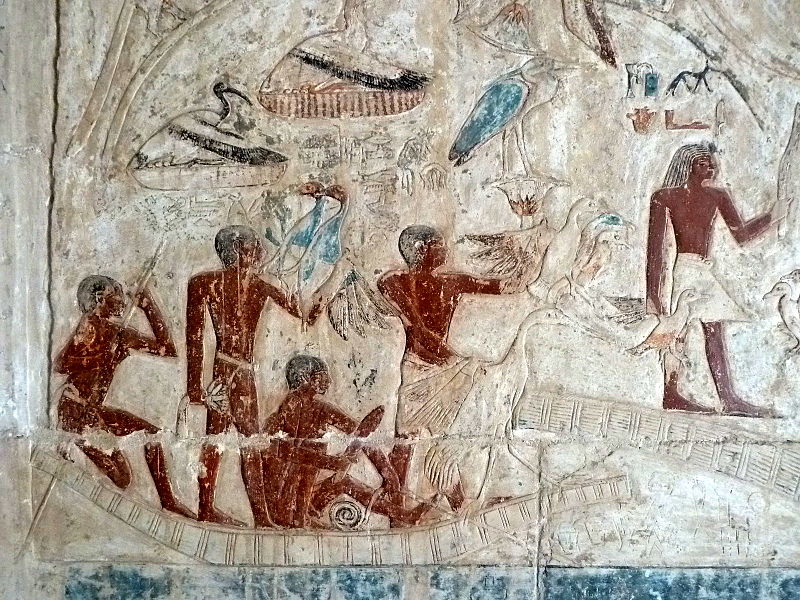 |
Playing sports on reed boats, temple of an unknown at Saqqara (2500 BC) (credit: Agyptisches Museum und Papyrussammlung)
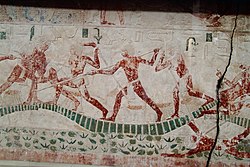 |
Model of a transit ferry from the 11th or 12th Kemetic Dynasty (2134-1784 BC), at the Art
Institute of Chicago, c. Mary Harrsch (no changes)
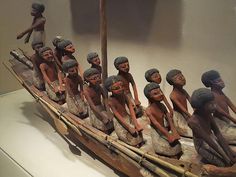 |
A model nobleman's fishing and hunting boat from the tomb of Meketre (1981-1975 BC)
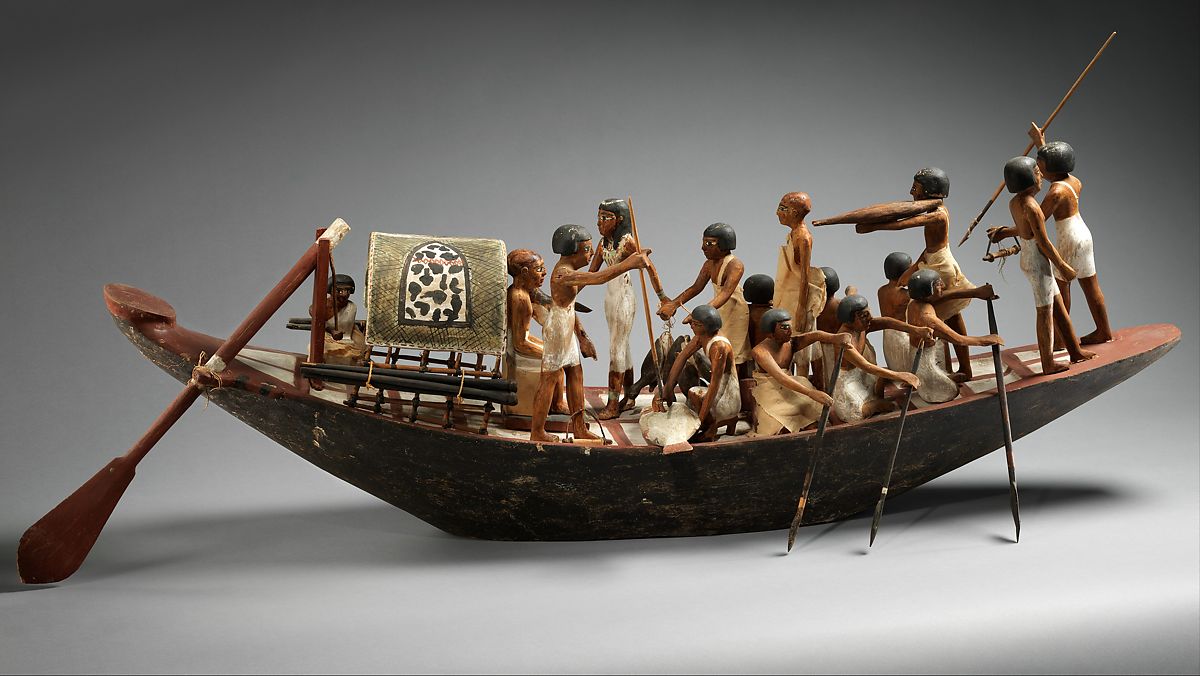 |
Ceremonial Uses
As aforementioned, ships were often used for ceremonial purposes. A model from Meketre's tomb shows a pilgrimmage to
the predynastic capital of Abydos, the original mecca where
the tomb of Asar (Osiris) is located. Noticeable differences in this ship versus those merely used for sporting or
fishing/hunting are that the ship used for pilgrimmages is larger, decorated and features a tall sailing mast, obviously
used for faster travel over longer distances and to travel south against the Nile's current. Such ships also served
as ancient limousines and hearses for the oldest documented funeral processions. Particularly in the era of the
so-called New Kingdom, elaborate scenes of riparian funeral processions became common in tombs of nobles througout the
Theban necropolis. For example, the tombs of Nebamun (1350-1300 BC) and Kyky (1292-1189 BC) feature numerous, well appointed ships
carrying people, including professional wailers, and one larger ship carrying the sarcophogus.
Professional wailers on a ship in Nebamun's riparian funeral procession (1350-1300 BC)
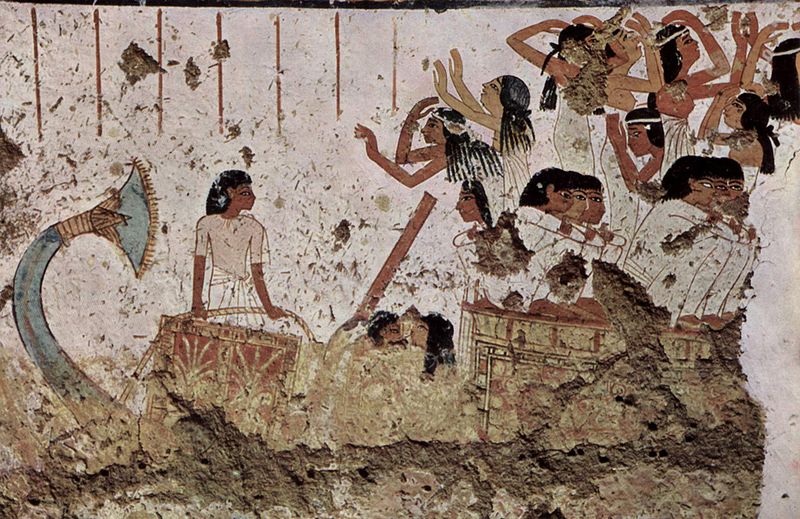 |
A model of Meketre's sailboat making a pilgrimmage to Abydos (1981-1975 BC)
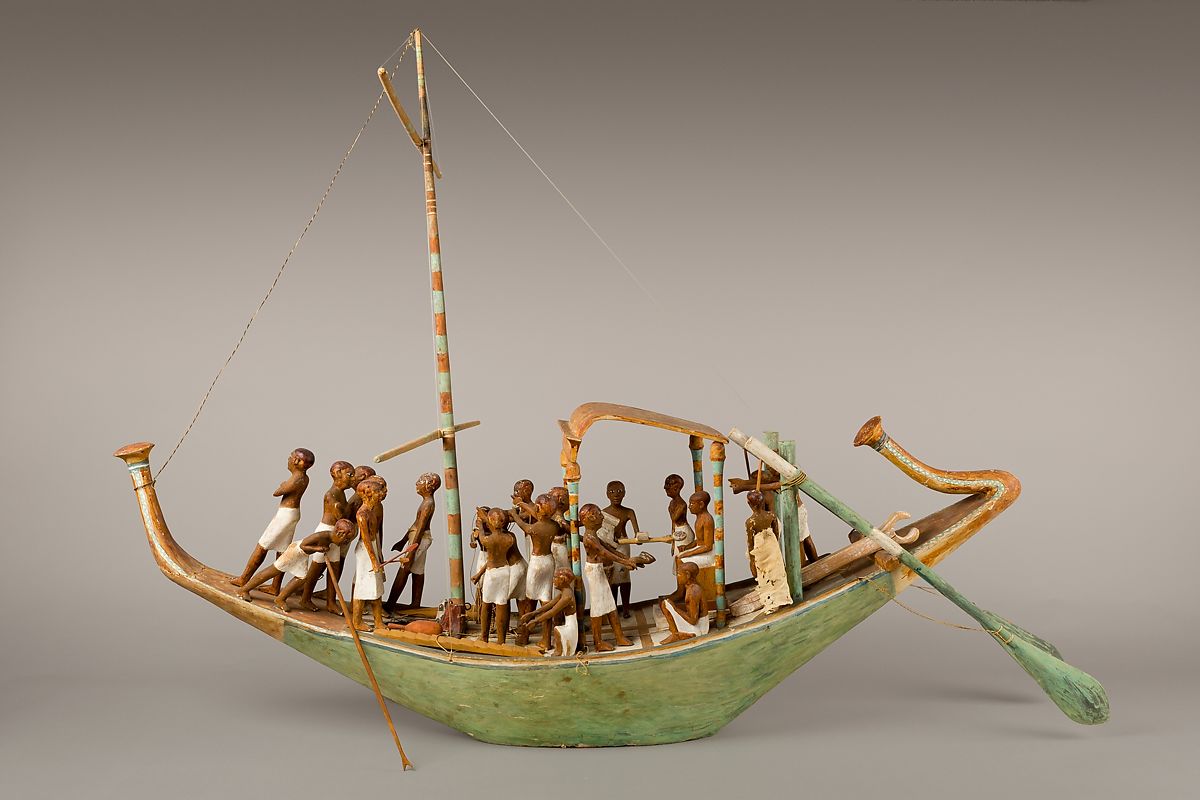 |
Foreign soldiers and their ship of war, in the tomb of Ramesses III at Medinet Habu (1186-1155 BC)
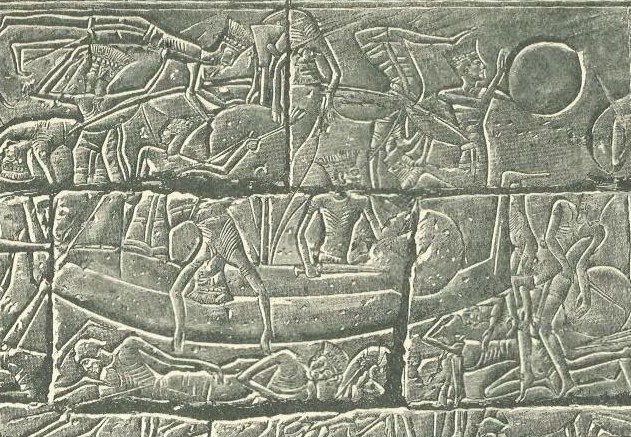 |
Oldest Naval Warfare
Nilotic people also documented their use of ships in battle. In fact, the world's oldest known representation of what could be considered naval warfare was carved on a knife found at
Gebel El-Arak near Abydos (3300-3200 BC). The object features hand-to-hand combat above several ships, suggesting a representation of
a naval battle. However the style of the engravings and the inclusion of a bearded figure, with a hat on the reverse seem more similar to ancient
artifacts found in Iraq, specifically from Ur. Perhaps this was an imported piece or simply styled after such artifacts from Ur.
More detailed documentation of early naval warfare, however, can be found at the tomb of Ahmose, Son of Ebana at El Kab (17-18th Dynasty, 1560-1520 BC),
who describes leading the navy on ships to defeat the foreign Hyksos at their capital of Avaris in the Nile Delta.
And at the tomb of Ramesses III (20th Dynasty, 1186-1155 BC) at Medinet Habu near Waset,
the written description of the Battle of Djahy is the longest Medu Neter (hieroglyphic) inscription ever found. It details
Ramesses III defeating the so-called "Sea People" (a broad term used to refer to the 7 groups of people named in the inscription: Denyen, Peleset, Shekelesh, Sherden, Teresh,
Tjekker, Weshesh) on ships.
Continue >>


























